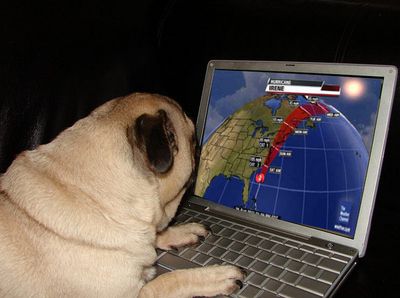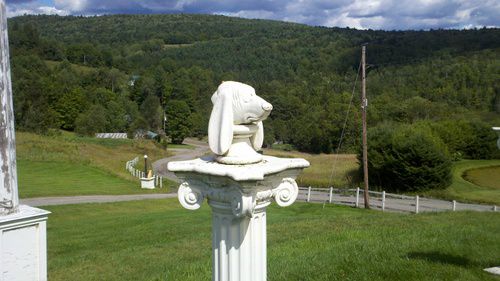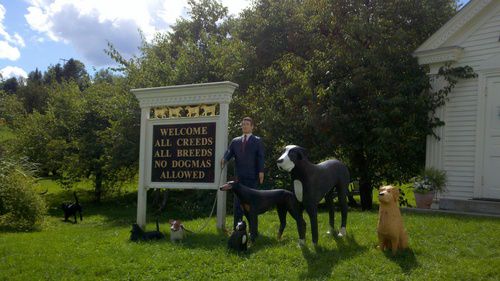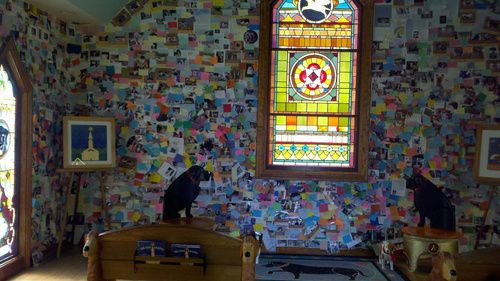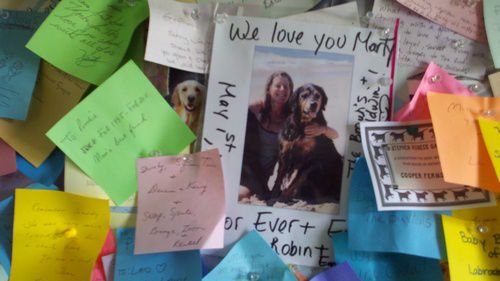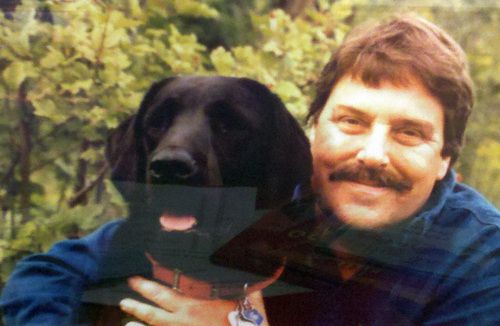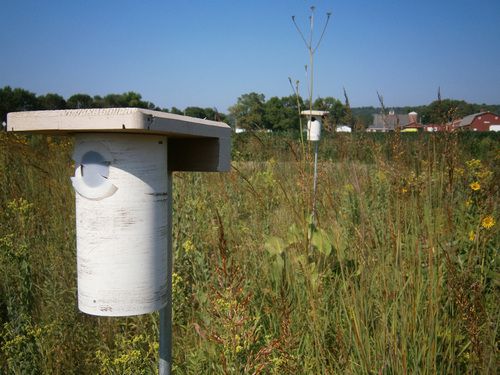Why the storm wasn’t overhyped, dogs and the mentally ill, the secret life of metal-detector hunters, the way we learn, and what the end of summer looks like.
The Monday Morning Rouser:
1) THE MOURNING AFTER
Irene is pretty much history now and all that’s left is the inexplicable braying about the hype that preceded it. In the end, what did we miss by having the news industry consumed with a rainstorm for a few days — the latest silly thing that a politician said? Worry not. There’ll be plenty more. But for those who couldn’t make it to the Minnesota State Fair this weekend, Irene coverage provided the best freak show in town.
There were the people who paraded behind the live standing-in-the-storm reports (warning: graphic content) …
… and the reporter who was standing in raw sewage without realizing it.
… then there’s the gallery of pug dogs preparing for the hurricane.
You already know what I think about reporters standing in water to cover a flood, so….
Our personal favorite, however, is meteorologist Paul Douglas’ reaction to the coverage (click below to get a more readable image).
A reporter standing in sewage during a hurricane? Not unexpected. Naked guys running behind a reporter? Predictable. Paul Douglas embarrassed by weatherpeople’s hype? That’s why Hurricane Irene will go down as a historic storm.
This was the scene around my mother-in-law’s neighborhood in the Berkshires. You know, I just don’t see Paul Douglas playing this down if it were in Minnesota.
Up the road in Vermont, this covered bridge no longer exists…
And there are these 25 images for people who think it was hype to consider.
The problem isn’t that the storm was a dud — 15 21 people are dead and damage may reach $7 billion. How many more would have had to die for the storm to meet expectations? — it’s that the TV people were trying to tell the story from the wrong location. People think of beaches and winds when there’s a hurricane. But it’s the rain and tornadoes that cause the destruction inland. No network stationed a reporter inland in anticipation of the storm, betraying their understanding of how hurricanes actually work.
Anyway, we’ll check back when that two-inch snowstorm hits the Twin Cities this winter and see how you downplay it, Paul Douglas.
2) DOGS AND THE MENTALLY ILL
Other than the phone call on the second day of vacation that my wife is losing her job, the vacation was just fine, thank you for asking. While that was the lowlight, this was the highlight:
This is Dog Mountain in St. Johnsbury, Vermont — my wife’s ancestral home. It was created by artist Stephen Huneck, who ran his gallery from the city, which is a pretty hardscrabble, straight-laced community of old New Englanders who once worked the mills, the woods, and the railroads. None of those jobs is coming back, but Huneck’s was doing well when he created the Dog Chapel.
Inside, it’s impossible not to reflect on the love between people and their dogs. From floor to ceiling, Post-It notes pay tribute to a long-lost pal…
But Dog Mountain comes with a heavy sadness beyond lost animal friends. Huneck suffered from depression and when the economy tanked in 2008, his business declined, he had to lay off people from his company and he faced losing the mountain. He shot himself in the head while sitting in his car outside his psychiatrist’s office.
So Dog Mountain is also a chance to reflect on the love — or quite often, the lack of it — between us and those who suffer from depression and are at war with their own brain.
It was a timely visit, given that many of those people are the people my wife helped. Her services are no longer needed and it’s not because there’s been a sudden drop in the number of people with mental illness who are desperate for help.
We are shameless in our deep devotion to our dogs. We have a long way to go to elevate the mentally ill to a dog’s status.
Here’s an article in a recent Yankee Magazine about Huneck and Dog Mountain that’s well worth taking the time to read.
3) THE SECRET LIVES OF METAL-DETECTOR HUNTERS
Wired magazine has jumped into the hobby of scavenging beaches and other locales in search of buried treasure. An example of what it found: Those romanticized moments of spreading ashes at sea, for example, often don’t end there.
People who ask to have their ashes scattered on the beach may think that their remains will simply disappear into the ecosystem, but little tokens can survive.
Cremation tags, metal discs the size of a quarter, are attached to each corpse as it arrives by the mortician. They are made to withstand the cremation and end up in the funeral urn, in case someone has to double-check the identity of ashes.
“When they go down and throw Uncle Fred off the cliff at the ocean, the tag will survive,” explains avid beachcomber Dennis Wilson.
4) THE WAY WE LEARN
NPR is reporting this morning that scientists have determined there is no evidence that people learn in different ways, ignoring the wisdom of parents of multiple children everywhere who know better.
5) THE END OF SUMMER
A week or so ago, I solicited your images of what the end of summer looks like to you. Reader Bill Bruins of Rochester says, “my end of summer is closing up the bluebird nest boxes.”
TODAY’S QUESTION
For students in Minneapolis and some other districts, today is the first day of school. For everyone else, the school year is just around the corner. Today’s Question: In your family, is the start of the school year a cause for happiness or dread?
WHAT WE’RE DOING
Midmorning (9-11 a.m.) – First hour: The perils of investing in a shaky stock market.
Second hour: The American Legion’s role in providing support to veterans and working with other organizations within the community.
Midday (11 a.m. – 1 p.m.) – First hour: Sen. Amy Klobuchar, from the Minnesota State Fair.
Second hour: Veterinarian Kate An Hunter answers your pet-care questions.
Talk of the Nation (1-3 p.m.) – First hour: TBA
Second hour: Rethinking eyewitness testimony.

